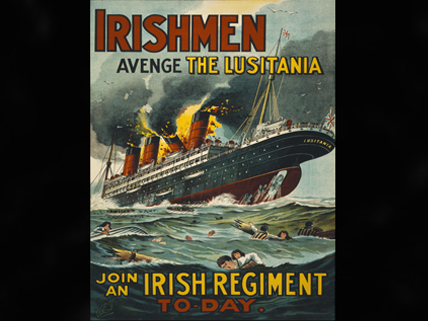
This recruitment poster used the sinking of the Lusitania in calling Irishmen to war against Germany.
On May 7, a century ago, a pivotal event of World War I occurred at sea, off the southern coast of Ireland. A German submarine, U-20, lay in wait as one of the world’s fastest, largest ocean liners approached, unescorted. The RMS Lusitania had crossed into the area designated a “war zone” by the German Imperial Navy. Steaming straight toward its destination, Liverpool, the British ship slowed to catch high tide in the shallow waters.
The U-boat sent a single torpedo streaking toward its target. The weapon struck the liner’s starboard hull, detonating on impact. A second, mysterious explosion followed, just seconds later, and the massive vessel began to sink. Passengers and crew scrambled for lifeboats, or simply jumped overboard. Fewer than two in five survived. Of the people on board, 1,198 died, among them 128 Americans. Within 18 minutes, the Lusitania was headed to the sea bottom.
Since February 1915, Germany had been conducting “unrestricted submarine warfare” in the Atlantic, in an attempt to counter the Royal Navy’s blockade of German ports. U-boats patrolled the waters around the British Isles. In the same New York newspapers that carried ads for the Lusitania’s voyage,the German embassy in the United States published warnings reminding travelers that they sailed to Britain at their own risk. The passengers and ship’s captain chose to ignore the threat. So did the British Admiralty, which sent no escort, even though it knew submarines were active in the area.
The killing of so many Americans at a time when the United States was still officially neutral was met by an outcry and calls for President Woodrow Wilson’s administration to respond. Although the incident did not immediately draw the nation into the war, the sinking of the Lusitania was a major contributing factor in the U.S. declaration of war on April 2, 1917. Images of the attack were featured on recruitment posters on both sides of the Atlantic.
Image credit: © Library of Congress, Prints and Photographs Division
Related Links
- The Sinking of RMS Lusitania, 100 Years Ago
Read the full story of the Lusitania’s career, its fateful sinking, and the impact on World War I.
(Source: History.com, May 6, 2015) - Lusitania: Who Was to Blame for the Deaths of 1,201 People?
BBC’s “iWonder” presents historical analysis of the fateful voyage, the prevailing conditions of submarine warfare, and the response of the British Admiralty; includes video excerpts (with transcripts) from a 1962 BBC investigation into the sinking, and an interactive feature that allows readers to lay historical blame.
(Source: BBC; accessed May 6, 2015) - “Lost Liners”: Lusitania
This PBS article features coverage of the attempts to explore the wreckage of the Lusitania.
(Source: PBS.org; accessed May 6, 2015) - The Sinking of the Lusitania
This encyclopedia article discusses Winsor McKay’s groundbreaking 1918 short propaganda film about the Lusitania, “the earliest surviving animated documentary and serious, dramatic work of animation”; includes link to view key parts of the film.
(Source: Wikipedia.org; accessed May 6, 2015)



